The Defense Department banned the display of unapproved flags, including the battle flag of the Army of Northern Virginia—better known as the “Confederate Flag”—in a new policy issued July 16.
Defense Secretary Mark T. Esper established the policy in a memo to the service Secretaries and other military and defense leaders, citing the imperative of “mutual respect, responsibility, and accountability” in “supporting our people.”
Esper never mentioned the confederate emblem, but his comments were clear references to it. “Flags are powerful symbols, particularly in the military community,” Esper wrote, before quoting the late Supreme Court Justice and World War II veteran John Paul Stevens on the United States flag as “a symbol of freedom, of equal opportunity, of religious tolerance, and of good will for other peoples who share our aspirations.”
In addition to the American flag, service members and civilian employees are authorized to display or depict, in public living and work spaces, only those that promote unity and esprit de corps, Esper said, providing a list:
- Flags of U.S. States and Territories and the District of Columbia
- Military Service flags
- Flag officer and general officer flags
- Presidentially appointed and Senate-confirmed civilian flags
- Senior Executive Service (SES) and Military Department-specific SES flags
- The POW/MIA flag
- Flags of allied or partner countries and those used for official protocol purposes
- NATO flags and those of organizations in which the United States is a member
- Ceremonial, command, unit, or branch flags or guidons
Not mentioned were flags related to political and social movements and causes, such as rainbow flags used to represent gay pride.
Esper was similarly detailed in describing the places covered by the new flag policy, which includes virtually any public space, including shared living spaces, office buildings, classified spaces, and other facilities; ships, aircraft, and government vehicles; hangars, garages, ready rooms, conference rooms, offices and cubicles; storage rooms, tool and equipment rooms, workshops, break rooms, kitchens, gyms, stores, and restrooms; barracks and common areas in other living spaces, schools, classrooms, and training facilities; and any other space in public or plain view, including porches.
The only exceptions cited are for historic and educational displays, monuments, and grave sites—so long as such uses cannot “be reasonably viewed” as having been endorsed by DOD, Esper wrote.


